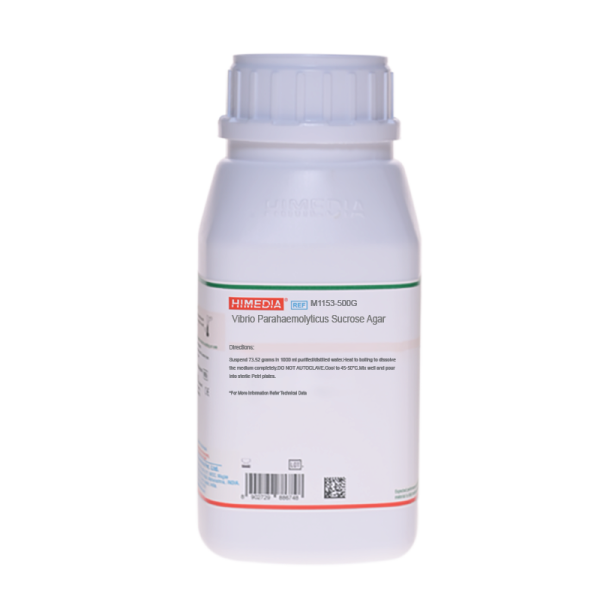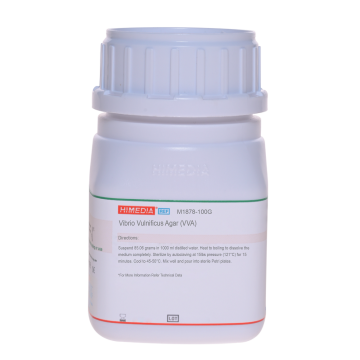 Your enquiry has been submitted
Your enquiry has been submitted
Vibrio Parahaemolyticus Sucrose Agar
Vibrio cholerae and NAG Vibrios#CC293D
Vibrio Parahaemolyticus Sucrose Agar (VPSA) is used for isolation and enumeration of Vibrio parahaemolyticus from seafood in accordance with APHA.
Composition
Ingredients
| Ingredients | Gms/Litre |
|---|---|
| Tryptose | 5.000 |
| Casein enzymic hydrolysate | 5.000 |
| Yeast extract | 7.000 |
| Sucrose | 10.000 |
| Sodium chloride | 30.000 |
| Bile salts mixture | 1.500 |
| Bromo thymol blue | 0.025 |
| Agar | 15.000 |
Final pH (at 25°C): 8.6±0.2
**Formula adjusted, standardized to suit performance parameters
Directions
Suspend 73.52 grams in 1000 ml distilled water. Heat to boiling to dissolve the medium completely. DO NOT AUTOCLAVE. Mix well and pour into sterile Petri plates.
Principle And Interpretation
Vibrio parahaemolyticus is a halophilic estuarine organism. This organism can be isolated from a variety of seafood products and marine environments. The organism, when isolated from fresh seafood, is usually found in low numbers (< 100/g) and is sensitive to refrigeration and heat.
Vibrio parahaemolyticus Sucrose Agar (VPSA) is recommended by APHA (1) for isolating and enumerating V. parahaemolyticus from seafoods. It is a differential medium (and also selective to some extent) that distinguishes V.parahaemolyticus from other marine Vibrios. This medium is employed in the final steps of Hydrophobic Grid Membrane Filtration enumeration procedure (HGMF) (2).
Tryptose, casein enzymic hydrolysate and yeast extract provide the necessary nitrogen compounds, growth factors and vitamin B complex for the growth of V.parahaemolyticus. Sucrose is the fermentable carbohydrate. Bromothymol blue is the pH indicator. Bile salts mixture inhibits the contaminating gram-positive bacteria. High salt content and alkaline pH of the medium provides conditions that facilitate easy recovery of Vibrio's. V. parahaemolyticus does not ferment sucrose and forms green to blue colonies which differentiates it from other sucrose fermenting Vibrio species.
Suspected seafood sample when diluted and blended with sterile peptone tween salt diluent, is filtered through HGMF using sterile diluent as a carrier. HGMF is then aseptically transferred to the Tryptic Soya Salt Agar with Magnesium Sulphate (TSAMS) (M990) plates and incubated for 4 hours at 35°C. HGMF is then transferred from TSAMS to the dry VPSA (M1153) plate and incubated for 18-20 hours at 42°C.
Quality Control
Appearance: Light yellow to pale green homogeneous free flowing powder
Gelling: Firm, comparable with 1.5% Agar gel.
Colour and Clarity of prepared medium: Blue coloured clear to slightly opalescent gel forms in Petri plates.
Reaction: Reaction of 7.35% w/v aqueous solution at 25°C. pH : 8.6±0.2
pH
8.40-8.80
Cultural Response
M1153: Cultural characteristics observed after an incubation at 42°C for 18-24 hours.
| Organism | Inoculum (CFU) | Growth | Recovery | Colour of colony |
|---|---|---|---|---|
| Staphylococcus aureus ATCC 25923 | >=10³ | inhibited | 0% | - |
| Vibrio parahaemolyticus ATCC 17802 | 50-100 | luxuriant | >=50% | blue-green |
Storage and Shelf Life
Store below 30°C in tightly closed container and the prepared medium at 2-8°C. Use before expiry date on the label.
Reference
- Downes F. P. and Ito K., (Eds.), 2001, Compendium of Methods for the Microbiological Examination of Foods, 4th Ed., APHA, Washington, D.C.
- Entis P. and Boleszczuk P., 1983, J. Food Prot., 46:783.
| Product Name | Vibrio Parahaemolyticus Sucrose Agar |
|---|---|
| SKU | M1153 |
| Product Type | Regular |
| Physical Form | Powder |
| Origin | Animal |
| Packaging type | HDPE |
| References | 1. Downes F. P. and Ito K., (Eds.), 2001, Compendium of Methods for the Microbiological Examination of Foods, 4th Ed., APHA, Washington, D.C. |
| Customized Product Available | No |







